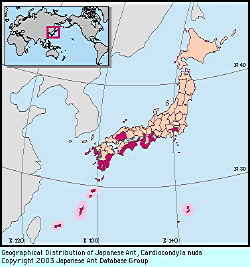
|
species
|
Cardiocondyla nuda
|
 |
Original Reference
|
|
Mayr, G. (1866) Myrmecologische BeitrŠge. Sitzungsberichte der k. Akademie der Wissenschaften. Mathematisch-Naturwissenschaftliche Classe 53: 484-517.
|
Synonym
|
|
Leptothorax nudus Mayr (Mayr, 1866) ,
Cardiocondyla nuda (Mayr) (Forel, 1881) ,
|
Description
|
|
Total length of workers around 2 mm. Body color blackish brown to black; legs, antennae and mandibles brown. Head rectangular, 1.15 times as long as wide; occipital border slightly convex. Mandibles each with 5 teeth, the apical largest. Scapes long, almost reaching occipital border of head. Metanotal groove shallow and weak in profile. Propodeal spines weakly developed, right-angled in profile. Petiole with a long peduncle, and with the node an inverted U-shape in profile; subpetiolar process small and spinose, situated on anteroventral portion of petiole. Postpetiole slightly lower than petiole in side view, 1.25 times as wide as long in dorsal view. Head and mesosoma shagreened; petiolar node, postpetiole and gaster smooth.
|
Remarks
|
|
Males are ergatoid - alate males have never been reported in this species. There are three types of ergatoid males: (1) with 12-segmented antennae and mandibles with 3 or 4 teeth, (2) with 12-segmented antennae and mandibles with 5 teeth, (3) with 11-segmented antennae. Ergatoid males mate with both alate females and dealated females in the nests. Nests are polygynous, with a high queen/worker ratio (reported to average 1.2 by Shindo, 1980). Colonies multiply by budding. It has been suggested that C. nuda originated in tropical Africa and extended its range almost world-wide as a tramp species, but there have been no records of this species from Africa. C. nuda is found in open habitats, as at the sea shore and on bare ground. It nests in the soil or under stones. Chromosome number 2n=28 (Imai & Kubota, 1981).
|
|

Distribution
|
|
Honshu (Kanto District and southwards), Shikoku, Kyushu, Nansei Is, Ogasawara Is, Volcano Is; India to Pacific Is, N America.
|
|
References
|
|
- Shindo, M. (1982). Notes on the mating behavior of the ergatoid males of Cardiocondyla sp. . J. BTAT, (18), 16-17.
- Yamauchi, K. & K. Kinomura (1993). Lethal fighting and reproductive strategies of dimorphic males in Cardiocondyla ants (Hymenoptera: Formicidae). . In T. Inoue & Sk. Yamane, eds., ""Evolution of Insect Societies"", 373-402. .
- Shindo, M. (1980). Notes on colony formation of Cardiocondyla sp. . J. BTAT, (16), 19-23 .
- Wilson, E. O. & R. W. Taylor (1967). The ants of Polynesia (Hymenoptera: Formicidae). . Pacif. Ins. Mon., 14, 1-109.
- Myrmecological Society of Japan, Editorial Committee (ed.) (Ed.). (1988). A list of the ants of Japan with common Japanese names. The Myrmecological Society of Japan, Tokyo.
- Forel, A. (1881). Die Ameisen der Antille St. Thomas. Mitt. Munchener Ento. Vereins 5: 1-16.
- Forel, A. (1881). Die Ameisen der Antille St. Thomas. Mitt. Munchener Ento. Vereins 5: 1-16.
- Imai, H. T. & M. Kubota (1981). Karyological survey of Indian ants. Some preliminary reports. . NucleusIndia, 24, 93-96.
- Myrmecologische BeitrŠge. Sitzungsberichte der k. Akademie der Wissenschaften. Mathematisch-Naturwissenschaftliche Classe 53: 484-517.
|
Editor
|
|
Original text by Mamoru Terayama, Katsusuke Yamauchi and Masaaki Morisita. English translation by Mamoru Terayama, edited by Robert W. Taylor
|
|